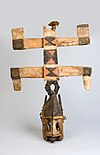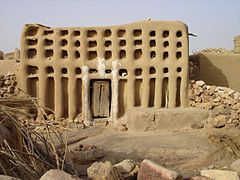Hogon

| Part of a series on |
| Traditional African religions |
|---|
 |

A hogon is a spiritual leader in a Dogon village who plays an important role in Dogon religion.
The life of a hogon
[edit]
A hogon is a religious figure as well as a temporal authority;[1] the hogon may be hereditary or may be chosen from among the village elders—custom varies from place to place. The hogon is always a man. After being chosen, a hogon must pass through several months without washing or shaving. After initiation, he wears a red cap, and a pearl bracelet. Hogon live alone and should be celibate, but a village girl may act as a maid. Nobody should touch the hogon.[2]
Ritual
[edit]
The hogon has a key role in village rituals and in ensuring fertility[3] and germination.[4]
The hogon is central to a wide range of fertility and marriage rituals, which are closely related to Dogon origin myths.[5]
The hogon may conduct rituals in the Sanctuaire de Binou, a special building the door of which is blocked with rocks.[6]
Creation myth
[edit]According to legend, the first hogon, Lebe, was descended from a nommo. He was eaten by another nommo, and their spirits merged; the nommo vomited out a new Lebe (part human and part spiritual), plus copious liquid which shaped the landscape.[7]
See also
[edit]References
[edit]- ^ Imperato, Pascal James (1978). Dogon cliff dwellers: the art of Mali's mountain people. L. Kahan Gallery/African Art. p. 12.
- ^ "hogon | African religious leader | Britannica". www.britannica.com. Retrieved 2022-05-25.
- ^ Bonnefoy, Yves (1993). American, African, and Old European mythologies. University of Chicago Press. pp. 123. ISBN 978-0-226-06457-4.
- ^ Heusch, Luc de (June 1997). "Les mécanismes symboliques de la royauté sacre: à la re-découverte de Frazer". Journal of the Royal Anthropological Institute (2).
- ^ Dieterlen (1956). "Parenté et Mariage Chez les Dogon". Africa. 26 (2): 107–148. doi:10.2307/1156839. JSTOR 1156839. S2CID 145001767.
- ^ "hogon | African religious leader | Britannica". www.britannica.com. Retrieved 2022-05-25.
- ^ Imperato, Pascal James (2001). Legends, sorcerers, and enchanted lizards: door locks of the Bamana of Mali. Africana Publishing. ISBN 978-0-8419-1414-8.
